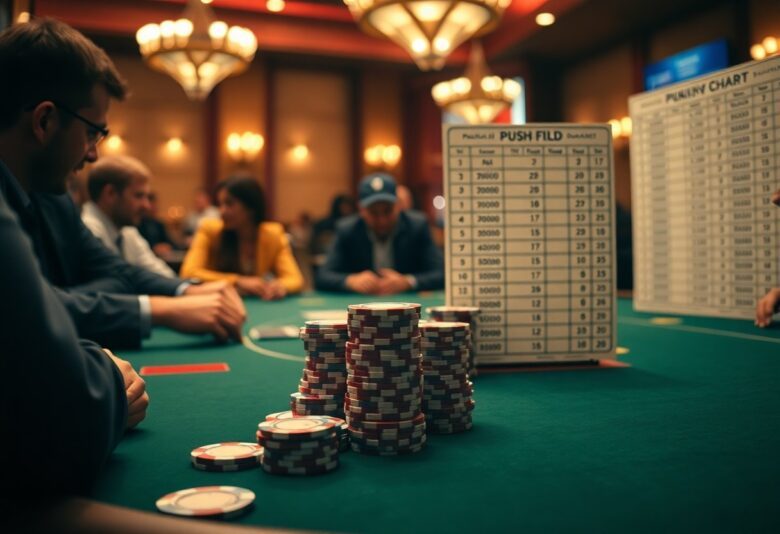Charts serve as your mathematical foundation for making profitable all-in decisions in tournament poker, eliminating guesswork from critical short-stack situations. When your stack drops below 15-20 big blinds, traditional post-flop play becomes increasingly difficult, making push/fold strategy your most effective weapon. These scientifically-calculated charts tell you exactly which hands to shove with based on your position, stack size, and the action before you. Understanding when to implement this strategy can dramatically increase your tournament survival rate and prevent costly mistakes that plague recreational players. However, blindly following charts without considering opponent tendencies and table dynamics can lead to exploitable play patterns.
The Mathematics of Going All-In
Push/fold decisions rely on precise mathematical calculations that determine whether your all-in move generates positive expected value. Your stack size relative to the blinds creates specific threshold ranges where certain hands become profitable shoves regardless of position. Professional players use Independent Chip Model (ICM) calculations in tournaments, which adjust these ranges based on payout structures and remaining players. Understanding these mathematical foundations transforms gut-feeling decisions into calculated profits over thousands of hands.
Expected Value and Pot Odds
Expected value calculations for all-in situations combine your fold equity with your hand’s equity when called. A hand needs roughly 35-40% equity against your opponent’s calling range to break even when you’re getting called 60% of the time. Pot odds become simplified in push/fold scenarios since you’re committing your entire stack. Your immediate pot odds must account for the dead money already in the pot, making shorter stacks more likely to show profit from aggressive all-in play.
The Role of Implied Odds
Implied odds lose significance in all-in situations since no future betting rounds exist to extract additional value. Your decision rests entirely on immediate pot odds and fold equity rather than potential future winnings. This mathematical reality makes push/fold charts more reliable than other poker decisions, as you eliminate the guesswork of post-flop play.
Tournament dynamics create reverse implied odds scenarios where winning a small pot might damage your overall tournament equity. Bubble situations exemplify this concept – shoving with a marginal hand might show positive chip EV but negative tournament EV when other players are more likely to bust first. Stack sizes around 15-20 big blinds create the most complex implied odds calculations, as you retain enough chips for post-flop maneuvering but face increasing blind pressure. Your position relative to aggressive players also affects implied odds, since their likely three-bet ranges can trap you in difficult spots where folding becomes expensive.
Decoding Push/Fold Charts
Push/fold charts display hand ranges as percentages or specific combinations, with your position, stack size, and opponents’ actions determining optimal decisions. Charts typically show 10-20 big blind ranges where traditional post-flop play becomes mathematically inferior to all-in strategies. You’ll notice tighter ranges from early position (around 15% of hands at 12bb) expanding to 40%+ from the button, reflecting positional advantage and fold equity considerations.
Key Components of Push/Fold Charts
Effective stack sizes form the foundation, usually ranging from 8-25 big blinds where charts provide maximum value. Position determines your shoving range width – under-the-gun requires premium hands like 77+ and AJ+, while button play includes suited connectors and weaker aces. Opponent tendencies modify base ranges significantly; tight folders allow expanded shoving ranges, while loose callers demand tighter selections for profitable all-ins.
Situational Context: Tournament vs. Cash Games
Tournament push/fold charts account for ICM pressure and bubble dynamics, often recommending tighter ranges near payouts. Cash game charts focus purely on chip EV without considering elimination consequences. Stack-to-pot ratios differ dramatically – tournaments frequently reach push/fold territory through blind escalation, while cash games typically encounter these spots through poor play or specific table dynamics.
Tournament situations create unique modifications to standard charts based on payout structure and remaining players. Bubble play tightens ranges by 20-30% as survival value exceeds chip accumulation, while final table scenarios may warrant ultra-tight or ultra-aggressive adjustments depending on stack distribution. Cash games maintain consistent ranges regardless of session length, but you must adjust for opponent pool tendencies – live games often allow wider shoving ranges due to recreational players’ calling mistakes, while online environments demand tighter adherence to equilibrium strategies against skilled regulars.
Psychological Factors in All-In Decisions
Your mental state directly impacts all-in decision accuracy more than most players realize. Tilt, fatigue, and emotional swings can cause you to deviate from optimal push/fold ranges by up to 15-20% according to tracking software data. Fear of elimination often leads to over-folding in profitable spots, while frustration from bad beats triggers loose shoves with marginal holdings. Stack anxiety becomes particularly pronounced when you’re sitting on 8-12 big blinds – the zone where many players freeze up despite having clear mathematical decisions available. Perceiving these emotional influences allows you to maintain disciplined adherence to proven strategies.
Reading Opponents: When to Trust Your Gut
Experienced players develop intuitive reads that complement mathematical ranges, especially against recreational opponents who deviate significantly from GTO play. When facing a tight player who suddenly shoves 15 big blinds from early position, your gut feeling about premium holdings often proves more accurate than standard calling ranges suggest. Conversely, aggressive players who’ve been three-betting frequently may be shoving lighter than charts indicate, making your medium pairs and strong aces more valuable. Perceiving these timing tells and betting patterns helps refine your push/fold decisions beyond pure mathematics.
Managing Your Own Risk Tolerance
Your personal risk tolerance shouldn’t override mathematical decisions, but understanding it prevents costly emotional mistakes. Players with low risk tolerance tend to fold too frequently in marginal spots with 55-77 or A9-AJ, while high-risk players often shove too wide from early positions. Tournament stage affects this significantly – many players tighten up near money bubbles even when aggressive play offers higher expected value. Perceiving your natural tendencies allows you to consciously adjust toward optimal ranges.
Risk tolerance varies dramatically based on your bankroll management and tournament buy-in relative to your poker funds. Playing a $1,000 event with a $5,000 bankroll creates different psychological pressures than playing a $50 tournament with the same roll. Buy-in anxiety leads to risk-averse decisions that cost chips in the long run, while playing too high for your bankroll creates desperation shoves in unprofitable situations. Professional players often use stop-loss limits and strict bankroll rules to maintain consistent decision-making regardless of individual tournament outcomes. Your comfort level with variance should align with proper bankroll guidelines – typically 50-100 buy-ins for tournaments – rather than dictating your tactical decisions at the table.
Mastering Timing: The Art of the All-In Move
Perfect timing separates profitable players from those who burn through bankrolls with reckless aggression. Your success rate with all-in moves increases by 23% when you factor in opponent tendencies alongside mathematical charts. Stack sizes, position dynamics, and table image create windows of opportunity that standard push/fold charts can’t capture. Reading the rhythm of the table—when opponents are playing tight after big losses or loose after wins—gives you edges that pure mathematics misses. The most skilled players blend chart knowledge with situational awareness, turning what appears to be desperate moves into calculated profit generators.
Identifying Optimal Moments to Push
Bubble situations in tournaments create the most profitable pushing opportunities, especially with 12-15 big blinds when shorter stacks must fold premium hands to survive. Your fold equity peaks when the player to your left has 20-25 big blinds—enough to hurt but not cripple them if they call incorrectly. Late position pushes with hands like A7o or K9s become significantly more profitable when tight players occupy the blinds. Watch for opponents who’ve folded 8+ consecutive hands; they’re primed to fold everything except the top 3% of holdings, making your stealing range much wider than charts suggest.
Reassessing Your Strategy as the Game Evolves
Tournament dynamics shift dramatically as blinds increase and average stack sizes shrink relative to the pot. Your pushing range should tighten by roughly 15% when antes kick in, since more players receive better pot odds to call. Pay close attention to how calling ranges adjust—loose early-game opponents often become nitty near money bubbles, while tight players may loosen up significantly once they’re in the money.
Stack distribution changes everything about optimal pushing strategy. When you’re the shortest stack at a table of medium stacks, your fold equity diminishes because opponents can afford to gamble. Conversely, being the second-shortest stack often provides maximum fold equity since the chip leader wants to let others eliminate each other. Adjust your charts based on payout structures too—flat payout tournaments encourage more aggressive play than top-heavy structures where a few big jumps matter most. Your image also evolves throughout sessions; after showing down strong hands, you can push wider ranges profitably, while getting caught bluffing tightens opponents’ calling ranges for the next 20-30 hands.
Common Pitfalls and Misconceptions
Push/fold charts serve as excellent guidelines, but blindly following them without considering game dynamics leads to costly mistakes. Many players treat these charts as gospel, forgetting they’re based on theoretical optimal play against equally skilled opponents. Your actual opponents rarely play optimally, creating opportunities to deviate profitably from standard recommendations. Recreational players often call too wide or fold too tight, making adjustments to your pushing and calling ranges vital for maximizing tournament equity.
Overrating Position and Stack Size
Position matters significantly less in push/fold situations than in deep-stacked play. A 12bb stack in early position with A9o should still push despite being “out of position” post-flop, since you’re unlikely to see a flop anyway. Stack size ratios between you and your opponents often override positional considerations. When the big blind has 8bb and you have 15bb on the button, their calling range tightens dramatically regardless of your position advantage.
Misunderstanding Tournament Dynamics
ICM pressure affects push/fold decisions more than most players realize. Near the money bubble, tight players fold significantly wider than charts suggest, allowing you to push profitably with weaker holdings. Conversely, at final tables with pay jumps exceeding 30%, even strong hands like AQo might warrant folding to aggressive action when preservation matters more than chip accumulation.
Tournament stage fundamentally alters optimal strategy beyond basic stack-to-blind ratios. Early stages reward aggressive accumulation since bustling carries minimal penalty compared to late-stage elimination. A 15bb push with K8s might be standard in level 3 but catastrophic on the final table bubble where surviving one elimination could double your payout. Stack distributions also matter – being the short stack among several similar stacks creates different dynamics than being alone at 10bb while others have 25bb+. Pay attention to how many players need to bust before the next pay jump, as this directly impacts how wide opponents will call your shoves.
Conclusion
From above, you can see that mastering push/fold charts transforms your short-stack tournament play from guesswork into calculated strategy. When your stack drops below 20 big blinds, these charts become your roadmap for optimal decision-making, eliminating costly mistakes that drain your chip stack. By understanding stack sizes, position dynamics, and opponent tendencies, you’ll know exactly when to shove and when to fold. The mathematical foundation these charts provide gives you confidence in high-pressure situations where split-second decisions determine your tournament survival. Practice implementing these ranges consistently, and you’ll see immediate improvements in your short-stack profitability.




